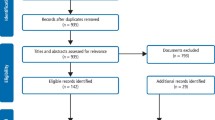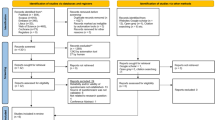Abstract
This paper is a narrative review of relevant literature.
Similar content being viewed by others
A commentary on
Mallineni S K, Innes N P, Raggio D P, Araujo M P, Robertson M D, Jayaraman J.
Coronavirus disease (COVID-19): Characteristics in children and considerations for dentists providing their care. Int J Paediatr Dent 2020; 30: 245-250.

GRADE rating
The novel virus Severe Acute Respiratory Syndrome Coronavirus 2 (SARS-CoV2), caused the coronavirus disease (COVID-19) pandemic. Paediatric patients should be considered as potential carries of COVID-19. This review addressed clinical aspects of the disease in children, drew conclusions about treatment of paediatric patient in the dental setting, informed about country specific approaches and recommendations to handle COVID-19 and discussed the role of guidelines and professional judgment in clinical decision-making.
Commentary
The world is facing an unprecedented time. The novel virus Severe Acute Respiratory Syndrome Coronavirus 2 (SARS-CoV2), first identified in Wuhan, China, caused the so called new coronavirus disease (COVID-19) outbreak. Due to its high transmissibility rate and the globalisation, SARS-CoV2 rapidly spread through countries and continents. As a result, on March 11 2020, the World Health Organisation declared COVID-19 as a global pandemic. Since then, the number of cases and deaths has increased exponentially each day.
COVID-19 can be transmitted human-to-human mainly through airborne droplets and splatter from respiratory secretions, saliva and blood through direct or indirect contact with mucosa and contaminated fomites. To date, measures such as frequent cleaning of hands with soap and water or an alcohol-based hand rub; avoiding touching eyes, nose or mouth; covering nose and mouth with bent elbow or a tissue when coughing or sneezing; and social isolation are effective in preventing the spread of the COVID-19. In cases of fever, cough and difficulty breathing, medical attention should be sought.1

© andresr/E+/Getty Images Plus
Since the report of the first case of COVID-19 in January 2020,2 researchers worldwide have worked tirelessly to understand the epidemiological and clinical aspects of the disease in order to achieve effective approaches to prevent contamination, to create accurate and reliable rapid tests and to treat those who have already contracted the disease. A simple search in PubMed using the key-word COVID-19 resulted in 12,959 papers by May 16 2020. Data have shown that human beings of all ages are susceptible, but clinical aspects of the disease in children are yet to be fully comprehended.
The aim of this well-written, clear and focused review was to report gathered data of reported cases of COVID-19 on children and to highlight considerations for dental professionals providing care during the pandemic.3 To illustrate how COVID-19 is exponentially spreading around the world, the authors of the review stated that, on March 31 2020, there were 857,487 confirmed cases and 42,106 deaths. Less than two months later, on May 16 2020 (11:33 am, Central Standard Time), there were 4,577,988 confirmed cases with 308,899 lives lost in 188 countries/regions.4 It should be emphasised that these numbers are underestimated, since many countries have a low rate of testing for suspected cases.
The review divides the data into four major topics: clinical aspects of COVID-19 in children; the child patient in the dental setting; country specific approaches and recommendations; and the role of guidelines and professional judgement. The authors highlighted that dental professionals must regularly seek and use reputable and reliable sources to keep themselves updated with the latest evidence-based information on managing paediatric patients in their own local circumstances.
Signs and symptoms of COVID-19 can have a wide range of presentations, from asymptomatic to critical illness. In the majority of patients, typical clinical symptoms include dry cough (usually accompanied by fever), but difficulty in breathing and fatigue among other less frequent symptoms can also be present. Children may be asymptomatic or exhibit mild or even nonspecific symptoms. However, deaths of children have been reported in newborns, preschoolers, children and adolescents. Therefore, it is important to remember that even asymptomatic children may rapidly progress to more critical illness.
All paediatric patients should be considered as potential carries of COVID19. Since dental professionals are at high risk of contamination, the authors recommend that besides following universal precautions in the dental setting, an infection prevention checklist should be used. This is crucial for the avoid of of the epidemicance cross-infection. Personal protective equipment, such as the N-95 respirator or Filtering Facepiece Respirator masks, are strongly indicated in managing children, although it is not a universal recommendation.
Countries are in different phases of the epidemic at different times, which limits the adoption of universal guidelines. Moreover, some countries have managed public health measures better than others. Hence,the authors stress that strictly following local evidence-based guidelines is essential.
Guidelines cannot always cover all possible situations. Therefore, authors reinforce that professional judgement must be exercised to help clinical decision making on whether to provide treatment or not. Dental treatment should only be carried out under rigorous adherence to appropriate guidelines and if it is considered safe for the dental team, the paediatric patient and the caregivers. If treatment is judged to be safe and necessary, dental professionals should perform the less invasive procedures, such as atraumatic restorative treatment, use of fissure sealants and silver diamine fluoride, selective caries removal and the Hall technique, to avoid aerosol generating procedures. Toothbrushing with fluoridated toothpaste should be reinforced to paediatric patients through telephone and video consultations with caregivers.
We must remain safe and vigilant until all possible scientific evidence is gathered and available for the control of the pandemic.
References
World Health Organisation. Coronavirus disease (COVID-19) advice for the public. 2020. Available at https://www.who.int/emergencies/diseases/novel-coronavirus-2019/advice-for-public (accessed May 2020).
World Health Organisation. WHO Timeline - COVID-19. 2020. Available at https://www.who.int/news-room/detail/27-04-2020-who-timeline---covid-19 (accessed May 2020).
Mallineni S K, Innes N P, Raggio D P, Araujo M P, Robertson M D, Jayaraman J. Coronavirus disease (COVID-19): Characteristics in children and considerations for dentists providing their care. Int J Paediatr Dent 2020; 30: 245250.
Coronavirus Resources Centre, Johns Hopkins University of Medicine. https://coronavirus.jhu.edu/map.html. Accessed on May 16 2020.
Author information
Authors and Affiliations
Rights and permissions
About this article
Cite this article
Martins-Júnior, P., Carvalho Oliveira Coutinho, D. & Martins Paiva, S. Implications for dental professionals when caring for paediatric patients. Evid Based Dent 21, 54–55 (2020). https://doi.org/10.1038/s41432-020-0093-7
Published:
Issue Date:
DOI: https://doi.org/10.1038/s41432-020-0093-7



